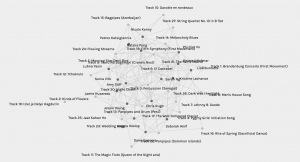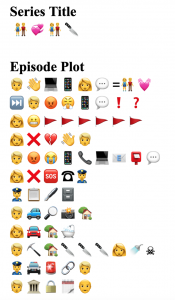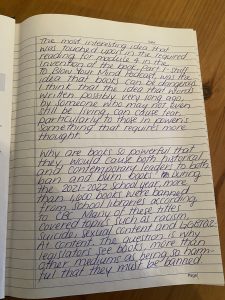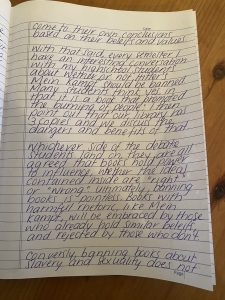The Story
“When I first graduated from University I took my first teaching job in Cairo Egypt it was really awesome experience because Egypt is so centrally located that we got to go on lots of trips within an outside of Egypt today I’m going to tell the story of one time when we got in a little bit of a dangerous situation when we were traveling around and seeing what you just had to offer so a couple people that I worked with at the international school and I decided we were going to go on a desert tour this was basically a 3-day trip through that What’s called the Pharaoh Oasis is where we started and then we are going sand boarding and dune bugging in the white and black deserts and at night sleeping under the stars having meals with bed winds very cool experience so the first thing we get there is really excellent or going around we’re seeing the desert or in these four by fours very cool we have dinner by the fire we sleep under the stars in the desert really cool experience the next day we are going sandboarding in the white desert now the sand dunes are super deep with really soft kind of sand and these vehicles are ripping around we had three different Vehicles each holding about 10 people I was in the first car and we are going up really steep Sand Dune and then down and I turn around to see that the car behind us had actually flipped coming down one of these sand dunes at first it was pretty surreal I couldn’t believe it really what was happening but the tables and all of the things I have been strapped to the top of the vehicle are now left right and center the car is on its roof when we get to the vehicle we see that the person who was in the front seat was now in the back many people had kind of some gas is some cut some injuries there was both foreigners and bedwins in this vehicle so some of the injuries were harder for us to assess from the bed wins in particular who only spoke Arabic so I’ve been trained in first aid since I was about 13 years old and they always say you know if something happens you’ll know what to do your first aid training will kick in however that was not the case for me and I kind of froze I didn’t really quite know what to do but luckily there were some people on the trip who were very well versed in kind of started delegating tasks you deal with this you deal with this in the end there was some a bit of like head injuries but nothing too serious gashes but there were broken collarbones broken ribs it was a whole kind of first aid operation because we were so far out in the desert that when essentially one of the bed ones who was not injured said he was calling for help what help actually was was another group of bedwings to come out with a new vehicle so that took about 2 hours for the new vehicle to arrive at which point the people who are injured were in the new vehicle and they were driving another 2 hours back to the closest Village that had a doctor now that said this doctor would have been someone working out of their home and it was another about 5-Hour Drive pyro so in the end most of the people on the trip ended up leaving either to go seek medical help or to be with those seeking medical help on the other hand didn’t actually know anyone who was in the second vehicle so we ended up staying and continuing on for another day of sand boarding but it was certainly a story that I will remember from my time in Egypt.”
Reflection
The first thing that is noticeable upon reading the output of the speech to text story that I recorded using Speechnotes, is that it is almost completely lacking any sort of punctuation or organization. This particular program does not recognize pauses as opportunities to insert commas, periods, or breaks in text. This lack of punctuation also led to some really funky choices in capitalization, making it more difficult to interpret nouns, and placing emphasis where it shouldn’t be. I feel that reading back to this text to speech story makes it obvious why we have conventions in written english; because it makes text easier to interpret and understand. I would consider the lack of punctuation throughout the story to be ‘mistakes’, because their lack of presence in the story makes it significantly more difficult to read and understand the cadence and sequence of the events in the story. This makes the experience of reading the story back to be quite jarring and led me at points not to understanding what was happening in my own story.
With that said, the speech to text did actually give me some grace, in that it did not relay the long pauses in my story where I stopped to gather my thoughts and remember details from the story. This could perhaps be something that could be considered ‘right’ within the text, along with general spelling conventions that lapse only occasionally. The spelling in the text is mostly ‘right’ except for when it comes to names of places that are not English. For example, “Baharaya Oasis” was changed to “Pharaoh Oasis” (noticeably still not an English word, but perhaps one more commonly used in English), and “bedouins” was changed to “bed wins”. It makes sense that the speechnotes program would recognize English being spoken and try to interpret all speech sounds in the same language, this may actually be something considered to be ‘right’, although in the context of the story it is ‘wrong’. In telling this story, my speaking style is very casual, especially considering the ad-libbed nature of the story. It is one that I have not told in many years so it felt quite off the cuff. This casual speaking style is really reflected in the written output. If I were to edit this written output and make it “right”, or if it had been scripted, I would make it sound more formal – as writing typically is. I do however understand that what is considered ‘wrong’ or ‘right’ for me are largely directed by cultural ideas of how writing should be.
Oral storytelling is very important in many Indigenous groups because it connects people and communities in a way that written storytelling does not. Oral storytelling is a group activity, where as written storytelling is primarily an individual activity. As Gnanadesikan (2011), Ong (2002) and Haas (2013) all explain, the first form of storytelling was oral, and limited to the immediate audience. Writing technology then revolutionized the communication of stories and made them more permanent and therefore available to much broader audiences. This is perhaps why I felt the urge to edit the output of my oral story and make it more formal and edit the writing conventions. When telling a story, I am not worried about little mistakes or perhaps lapses in accuracy because the story feels like it ends as soon as it is told. When we write a story on the other hand, the feeling of permanence that comes with composing writing, makes following conventions feel more necessary.
Schmandt-Besserat and Erard (2007) argued that oral storytelling is ephemeral and relies on the audience’s memory. I thought this was interesting and it caused me to reflect on the story and how much of what I remember may have changed since the events occurred. I feel that if I had written down the story, the specifics would be more accurate and detailed, where the reality of not having written down the events after they happened, parts of this story have likely been elaborated, diminished or changed as the story relies on my memory alone. These mistakes or changes in the story make it ‘wrong’, but this is also perhaps part of the beauty of oral storytelling, that it evolves over time through various tellings of the story.
References
Gnanadesikan, A.E. (2011). The first IT revolution. In The writing revolution: Cuneiform to the Internet (pp. 1-12). John Wiley & Sons.
Haas, C. (2013). The technology question. In Writing technology: Studies on the materiality of literacy (pp. 3-23). Routledge.
Ong, W.J. (2002). Chapter 1: The orality of language. In Orality and literacy: The technologizing of the word (pp. 5-16). Routledge.
Schmandt-Besserat, D., & Erard, M. (2007). Origins and forms of writing. In C. Bazerman (Ed.), Handbook of research on writing: History, society, school, individual, text (pp. 7-26). Routledge.
Speechnotes.com






